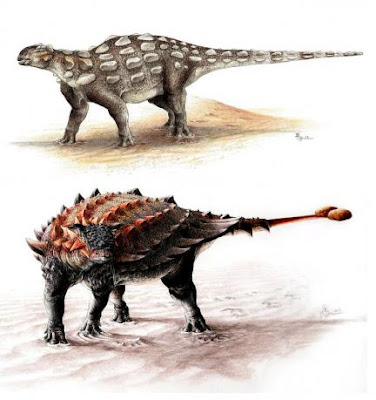One
of the most impressive weapons that appeared during the Cretaceous
Period dinosaur arms race is a big mace head belonging to some group
members plant eaters.
Results
of a new study published in the Journal of Anatomy this week showing
the steps of evolution of the features typical of heavily armed dinosaur
Ankylosaurus and cousin, mace even ferocious Tyrannosaurus rex could
give reason for concern.
The
researchers studied the fossils of a group called Ankylosaurus,
including nightstick or mace early primitive species without the tail
and the latter with the tail fully developed.
 |
| Gobisaurus (top) compared with Ziapelta, an ankylosaur with a fully developed tail club, as seen in an undated illustration courtesy of Victoria Arbour. (Picture from: http://reut.rs/1i502UU) |
Ankylosaurus
tail evolution mace start much earlier than previously thought,
according to research findings, and the mace was changed in two steps
over tens of millions of years.
First,
the vertebrae in the back of the tail is changed so that the tail
becomes rigid. Then the bones are formed in the skin as body armor,
called osteoderm, becomes very large at the end of the tail and
completely enveloped the tail end to form a mace that can be swung to
the enemy.
Ankylosaurus
lived at a time when the largest land predators in Earth's history such
as T. rex roamed, ripping other dinosaurs with powerful jaws and sharp
teeth.
In the arms race, few plant-eaters to develop weapons of defense.
"The
tail mace clearly an effective weapon and could break an ankle
predator," paleontologist Victoria Arbour from North Carolina State
University and the North Carolina Museum of Natural Sciences who led the
study.
"But
the animals were alive today, guns are also often used against their
own species - like horn sheep and rusa-- so maybe Ankylosaurus do the
same thing."
Ankylosaurus dinosaur is
a wide body with four legs covered plates and spurs hard. The oldest
known Ankylosaurus lived about 160 million years ago during the Jurassic
Period, Arbour said.
The first tail mace seen already fully formed about 75 million years ago during the Cretaceous Period.
Ankylosaurus
with a length of approximately six meters is the biggest and the last
Ankylosaurus, live at the end of the dinosaurs about 65 million years
ago.
Ankylosaurus
from China is very important to understand the origin of the tail mace,
including Gobisaurus, from the period around 92 million years ago, and
Liaoningosaurus, from about 122 million years ago, explains Arbour as
reported by Reuters news agency. *** [EKA | FROM VARIOUS SOURCES | REUTERS]
Note: This blog can be accessed via your smart phone.
